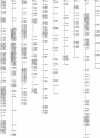Discovery and mapping of a new expressed sequence tag-single nucleotide polymorphism and simple sequence repeat panel for large-scale genetic studies and breeding of Theobroma cacao L
- PMID: 22210604
- PMCID: PMC3276266
- DOI: 10.1093/dnares/dsr039
Discovery and mapping of a new expressed sequence tag-single nucleotide polymorphism and simple sequence repeat panel for large-scale genetic studies and breeding of Theobroma cacao L
Abstract
Theobroma cacao is an economically important tree of several tropical countries. Its genetic improvement is essential to provide protection against major diseases and improve chocolate quality. We discovered and mapped new expressed sequence tag-single nucleotide polymorphism (EST-SNP) and simple sequence repeat (SSR) markers and constructed a high-density genetic map. By screening 149 650 ESTs, 5246 SNPs were detected in silico, of which 1536 corresponded to genes with a putative function, while 851 had a clear polymorphic pattern across a collection of genetic resources. In addition, 409 new SSR markers were detected on the Criollo genome. Lastly, 681 new EST-SNPs and 163 new SSRs were added to the pre-existing 418 co-dominant markers to construct a large consensus genetic map. This high-density map and the set of new genetic markers identified in this study are a milestone in cocoa genomics and for marker-assisted breeding. The data are available at http://tropgenedb.cirad.fr.
Figures



References
-
- Argout X., Salse J., Aury J.M., et al. The genome of Theobroma cacao. Nat. Genet. 2011;43:101–8. - PubMed
-
- Cheesman E.E. Notes on the nomenclature, classification and possible relationships of cocoa populations. Trop. Agricult. 1944;21:144–59.
-
- Lanaud C., Fouet O., Clément D., et al. A meta-QTL analysis of disease resistance traits of Theobroma cacao L. Mol. Breed. 2009;24:361–74.
-
- Lanaud C., Risterucci A.M., Ngoran A.K.J., et al. A genetic-linkage map of Theobroma cacao L. Theor. Appl. Genet. 1995;91:987–93. - PubMed
-
- Crouzillat D., Lerceteau E., Petiard V., et al. Theobroma cacao L.: a genetic linkage map and quantitative trait loci analysis. Theor. Appl. Genet. 1996;93:205–14. - PubMed
Publication types
MeSH terms
LinkOut - more resources
Full Text Sources
Research Materials

